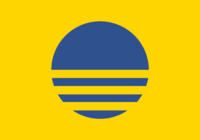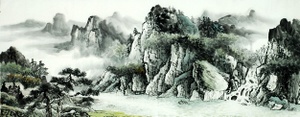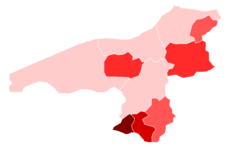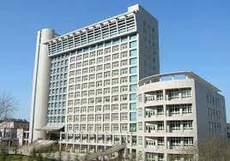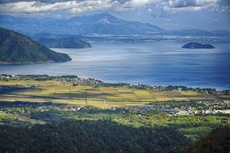Weishi
Weishi 伟石州 Wěishí zhōu | |
|---|---|
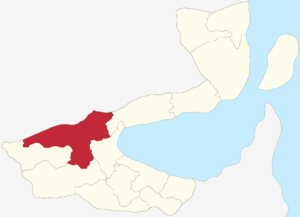 Map of Monsilva with Weishi highlighted | |
| Country | |
| State status | 1 July 1984 |
| Capital | Sanzhong (三中) |
| Government | |
| • Body | Weishi State Government |
| • Premier | Hsu Bai (RNP) |
| • Deputy Premier | Yeung Shui (RNP) |
| Population (July 2022) | |
| • Total | 1,909,182 |
| Time zone | TMB+10:00 (Monsilvan Western Time, MWT) |
| ISO 3166 code | MS-WEI |
| GRP (¥) | ¥373 billion |
| Major airports | Sanzhong City Airport (SZA) |
| Transit System(s) | MRA Sanzhong and Taimali RT |
| Police[1] | Weishi State Police |
| Ambulance[2] | Weishi State Ambulance |
| Fire[3] | Weishi Fire Service |
Weishi (Monsilvan: 伟石州; Pinyin: Wěishí zhōu), is a state of the Monsilvan Republic. The state has around 1.9 million people, with 45% of them living in the state's capital, Sanzhong. It is located in western Monsilva, sitting north of Wuzhong, Xishanjia and Bazhong, west of Xiaogu and south of the nation of Akvarelusus. Weishi is a large state, with a climate that ranges from temperate hills in the south to cold mountains and grasslands in the north. The state of Weishi is governed by the Weishi State Government, with Hsu Bai of the RNP being the current premier. The state is divided into 10 counties, 17 legislative constituencies and 42 municipalities and is represented by 3 Senators in the Senate and 17 members in the Legislative Assembly. The Weishi State Parliament consists of 42 seats, and is currently lead by the RNP, with the FDP leading the opposition.
Weishi is Monsilva's 5th least populous state, and has the sixth lowest urbanization of all the states, with 67% of the population living in urban areas. Weishi is a predominantly rural industry focused state, with the largest industries being sheep products such as wool and mutton. The agricultural industry is very large in Weishi, as the majority of its area is made up of farms. Sanzhong is Weishi's capital and biggest city. Weishi also has five other cities, Guobei, Wuden, Yuchi and another two which are 'honorary cities'; towns with a significant historical background. These 'honorary cities' are considered part of the state's urban population, despite not meeting some of the standard requirements for a city. They are Wen'an and Lunhuang, and are counted as urban regions despite their small sizes. Wen'an is located in the north-west of the state amongst the mountains, whilst Lunhuang is located in the north-east near the border with Xiaogu. Weishi has a nominal GRP of around ₵62 billion, giving it a GRP per capita of ₵32,425.
Weishi is served by the Monsilvan Railways Administration which connects the state to the rest of Monsilva. Sanzhong has the Sanzhong RT which is a tram network serving the city centre. Weishi has one major airport: Sanzhong City Airport. The Monsilvan high-speed rail service serves Dishui station in the outskirts of Sanzhong, and runs services to Wodai and Amking.
Contents
Toponymy
The name, Weishi comes directly from the HY Pinyin of the Monsilvan "偉石". The character "偉" means "great" in Monsilvan, and the character "石" means "rock". Therefore, Weishi directly translates to "great rock", which may refer to the Weishi mountain range, in which is Mount Yushan, the tallest mountain in Monsilva.
History
Prehistory and early dynasties
Weishi was the central region of the Han dynasty from its creation in 60 CE until its merge with the Zhou dynasty in 1201. Sanzhong was the capital of the dynasty throughout its existence, making it one of the oldest cities in the country. The Han dynasty was a very rural and traditional dynasty, preserving historical artifacts and buildings. Thanks to this, many buildings originating from during and even before the Han dynasty are still standing throughout Weishi, even in Sanzhong. The Han dynasty also classified Wen'an and Lunhuang as cities, as they had important Buddhist temples. This classification, although incorrect on modern-terms, remains due to its historical significance.
In 650 CE, along with the Later Qin dynasty, the Han dynasty invaded the Tang dynasty, and captured the region which is now the state of Xiaogu. This removed the border which is now Weishi's eastern border, which had been fought over between the Han and Tang dynasties for hundreds of years.
Zhou dynasty and the Empire of Baltanla
When the unificiation of the Monsilvan Kingdoms took place in 1201 CE, the largest Monsilvan dynasty, Shang, was run by a relative of the emperor of the Han dynasty, Emperor Zhou, which meant there was no trouble when unifying to form the Zhou dynasty. In the Zhou dynasty, Sanzhong became the capital of the Zhou dynasty, as it was where the Zhou emperor lived. Even though, Amking was by far the largest population center.
However, as time went on, and Amking kept growing at a much faster rate than Sanzhong, the capital was moved from Sanzhong in 1455 to Amking. However, during its time as capital, Sanzhong did see increased growth in population and the emperor living there meant it got a disproportionate amount of refurbishing and improvements compared to other cities and towns around the dynasty. In 1568, when the Zhou dynasty voluntarily ceded itself to the Empire of Baltanla, Weishi remained a spiritual region. However now that Baltanla, where Buddhism had begun, was part of the same empire, most pilgramiges were done to areas in Baltanla rather than Weishi, and the region saw the consequences of this through decreasing population and economy.
Kingdom of Great Shan and the Civil War
When the Kingdom of Great Shan left the Empire of Baltanla, it was in a very good position. Weishi was also established for the first time as an administrative division of the nation. Weishi also saw a regrowth in population thanks to the increase in foreign and domestic tourism and a large increase in land trade.
Battles of the Monsilvan Civil War took place all across the country, but there were many in northern Weishi. Fortunately, they were not near any population centers, and never reached the historical city of Lunhuang which was going to be a part of a scorched earth tactic if the Liberate Monsilva Movement got too close to the city. It did not, and it is thanks to that that Lunhuang is still standing.
Kingdom of Monsilva and the Republic
During the Kingdom of Monsilva, Weishi saw much needed funding after the war, as the population was suffering from significant poverty as the region was massively underfunded during the Great Shan. This also boosted the region's textile and agricultural industries which have grown a lot in size since.
Minimal protests took place in Weishi during the 1978 Monsilvan protests, likely due to population being more supportive of the incumbent government than many other parts of the country. However, when the Monsilvan Republic was established, the people of Weishi were very satisfied, as many had advocated for devolution to be granted to the region for several decades. In 1983, Weishi was granted devolution along with 9 other states. This established the Weishi State Government which has been lead by the Reformed National Party since its establishment.
Administration
Local government
The state of Weishi is governed by the Weishi State Government, based in the Weishi State Office in Sanzhong. The state parliament is a unicameral legislature consisting of a 42-seat State Parliament. Each municipality in Weishi is represented by one State Parliament Member. Members are elected for four-year terms. The Parliament meets every week, with the day depending on the first weekday after the state election which takes place in different states at different times. The leading party in the State Parliament determines who will be the Premier. Hsu Bai of the RNP has been the Premier of Weishi since 2013.
National government
Weishi is represented in the Parliament of Monsilva by 3 Senators in the Senate of Monsilva and 17 Members of the Legislative Assembly.
Geography
Weishi's geography is different depending on where you are in the state. In the west, the state is predominantly mountainous and rocky. The Weishi mountain range is Monsilva's largest range and consists of Mount Yushan, which is the tallest mountain in the country, and therefore also the highest point at 3,952 m (12,966 ft) above sea-level. Weishi Mountains National Park is also one of the largest national parks in the country, and contains the longest hiking-trail in Monsilva.
The south of Weishi is where most of the state's population lives, either in the city of Sanzhong or in the towns surrounding it. The rural landscape consists mostly of lakes, grasslands and hills. It is also where most of the state's agriculture is done. Similarly, the north and east of the state is mostly grassland, but is a lot colder (around 10-15 degrees Celsius average annual temperature) and is more flat.
Climate
Weishi is a very temperate state, with colder temperatures in the west due to high altitudes, and warmer temperatures in the south, where it is much lower down. Weishi has been known to receive tornadoes, although a one of significant size hasn't been recorded since 1952.
Demography
| Country of Birth | Population | Percent | |
|---|---|---|---|
| 1,687,717 | 88.4 | ||
| Non-Monsilvan | 221,465 | 11.6 | |
| 114,551 | 6.0 | ||
| 99,277 | 5.2 | ||
| Others | 7,637 | 0.4 | |
| Total | 1,909,182 | 100.0 | |
The 2022 census recorded that 221,465 people or 11.6% of Weishi's population were of non-Monsilvan descent. The table to the right shows the most common countries of origin of Weishi residents. 67% of Weishi's population live in cities, being Sanzhong, Guobei, Wuden, Yuchi, Wen'an or Lunhuang, which is also where the vast majority of Weishi's non-Monsilvan population lives. The other 33% are living in rural areas and is made up of predominantly Monsilvans.
Religion
Weishi has a majority Buddhist population. Around 64.6% of Weishi's population follow Buddhism to some extent. This is likely due to the deep historical connection between the people of Weishi and Buddhism, as it was brought over by Buddha himself to the region, along with Wuzhong and Xishanjia.
Also, as rural populations face less religious opposition due to lower immigrant populations, they are less likely to convert, as their entire lifestyle may revolve around the beliefs that originate from Buddhism. Many families would look down upon members that choose to disrespect their family traditions that have lasted for many decades, if not hundreds of years.
Following Buddhism in the census was Monsilvan folk religion at 31.1% of the population; then it was the 'Unaffiliated' category (people who do not follow any organized religion, including atheism and agnosticism) at 4.0%; and finally 'Other' (which includes Christianity and Islam) took up the last 0.3%.
Transport
Weishi's transport is administered by the state's Department for Transport, which is a sub-department of the federal Department of Transport. Weishi is served mainly by the Monsilvan Railways Administration in the south and in the other cities.
Sanzhong is served by the Sanzhong and Taimali RT, which is a rapid transit network consisting of trams and metro that serve the city of Sanzhong in Weishi and Taimali in Xishanjia.
Education
Education is mandatory until the age of 16 for children living in Meixian, which is the minimum age at the federal level. Weishi's towns and cities feature many schools, from elementary to high school. As well as this, Weishi is home to some higher education institutes including:
Sanzhong College is a small university in the city of Sanzhong which provides courses in a range of different subjects to students. Sanzhong College is known for having low entrance fees, and has been equally praised and critisized for giving priority to students facing economic trouble. Notably, current prime minister, Xu Yan, worked in the politics department at Sanzhong College from 1997 to 2002.
The University of Classical History in Lunhuang is Monsilva's only university dedicated purely to classical history. As the name suggests, students who go here are taught classical history, including both Monsilvan and foreign classical history. It ranks number one in the country for classical history, as one might expect.
Culture
Tourism
Weishi is scattered with ancient temples and buildings dating as far back as 300 CE. The main attraction for tourists in Weishi is its history, as opposed to its modern day culture, which has been identified and utilised by the Weishi government, which focuses mostly on maintaining older buildings rather than building new attractions. This has been met with criticism by the Weishi population, especially in Sanzhong. But it has clearly correlated with an exponential increase in tourism annually.
Weishi recieves around 4 million tourists annually. The most popular attractions and places include Longshan Temple, Lin Sun Lake, Weishi Mountains National Park, and the 'honorary cities' of Lunhuang and Wen'an.
Sport
The most popular sports in Weishi are yuchio and football. Yuchio has been the most popular sport in Weishi for a long time, even before the introduction of football to the country. There are many yuchio courts across the state, even in the most rural areas. Football also has a lot of popularity in the state, with two well-known professional teams being Sanzhong F.C. and Xiaoan Wolves F.C.. Sanzhong has made it into the Monsilvan Super League before, however both teams are currently in Challenge League 1.
